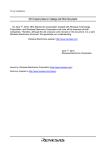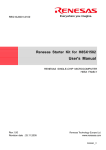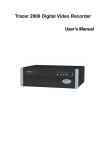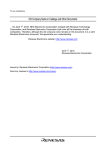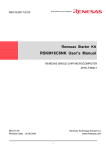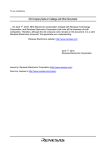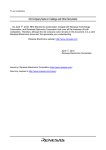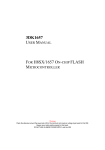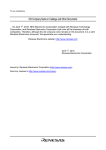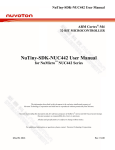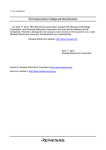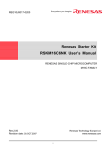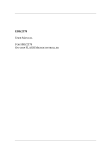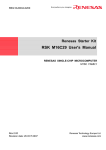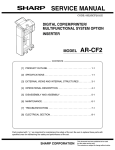Download Renesas Starter Kit for H8SX1582 User`s Manual
Transcript
REG10J0001-0100 Renesas Starter Kit for H8SX1582 User's Manual RENESAS SINGLE-CHIP MICROCOMPUTER H8SX FAMILY Rev.1.00 Revision date:25.11.2005 Renesas Technology Europe Ltd. www.renesas.com D005961_11 Table of Contents Table of Contents ...................................................................................................................................................ii Chapter 1. Preface .................................................................................................................................................4 Chapter 2. Purpose ................................................................................................................................................5 Chapter 3. Power Supply ......................................................................................................................................6 3.1. Requirements ..............................................................................................................................................6 3.2. Power – Up Behaviour................................................................................................................................6 Chapter 4. Board Layout.......................................................................................................................................7 4.1. Component Layout......................................................................................................................................7 4.2. Board Dimensions.......................................................................................................................................8 Chapter 5. Block Diagram.....................................................................................................................................9 Chapter 6. User Circuitry ...................................................................................................................................10 6.1. Switches.....................................................................................................................................................10 6.2. LEDs ..........................................................................................................................................................10 6.3. Potentiometer............................................................................................................................................10 6.4. Serial port.................................................................................................................................................. 11 6.5. LCD Module ..............................................................................................................................................12 6.6. Option Links..............................................................................................................................................13 6.7. Oscillator Sources .....................................................................................................................................14 6.8. Reset Circuit..............................................................................................................................................14 Chapter 7. Modes.................................................................................................................................................15 7.1. FDT Settings .............................................................................................................................................15 7.1.1. Boot mode............................................................................................................................................16 7.1.2. User Boot mode ..................................................................................................................................17 7.1.3. User Mode ...........................................................................................................................................18 Chapter 8. Programming Methods .....................................................................................................................19 8.1. Serial Port Programming .........................................................................................................................19 8.2. E10A Header .............................................................................................................................................19 Chapter 9. Headers..............................................................................................................................................20 9.1. Microcontroller Headers ...........................................................................................................................20 9.2. Application Headers..................................................................................................................................24 Chapter 10. Code Development ..........................................................................................................................26 10.1. Overview..................................................................................................................................................26 10.2. Compiler Restrictions .............................................................................................................................26 10.3. Mode Support ..........................................................................................................................................26 10.4. Breakpoint Support ................................................................................................................................26 10.5. Code located in RAM ..............................................................................................................................26 10.6. HMon Code Size ......................................................................................................................................26 10.7. Memory Map ...........................................................................................................................................28 ii 10.8. Baud Rate Setting...................................................................................................................................29 10.9. Interrupt mask sections .........................................................................................................................29 Chapter 11. Component Placement ....................................................................................................................30 Chapter 12. Additional Information ...................................................................................................................31 REVISION HISTORY .........................................................................................................................................32 iii Chapter 1. Preface Cautions This document may be, wholly or partially, subject to change without notice. All rights reserved. No one is permitted to reproduce or duplicate, in any form, a part or this entire document without the written permission of Renesas Technology Europe Limited. Trademarks All brand or product names used in this manual are trademarks or registered trademarks of their respective companies or organisations. Copyright © Renesas Technology Europe Ltd. 2005. All rights reserved. © Renesas Technology Corporation. 2005. All rights reserved. Website: http://www.renesas.com/ Glossary BRR Baud Rate Register ERR Error Rate HMON Embedded Monitor RTE Renesas Technology Europe Ltd. RSK Renesas Starter Kit RSO Renesas Solutions Corp. 4 Chapter 2.Purpose This RSK is an evaluation tool for Renesas microcontrollers. Features include: • Renesas Microcontroller Programming. • User Code Debugging. • User Circuitry such as switches, LEDs and potentiometer(s). • Sample Application. • Sample peripheral device initialisation code. The CPU board contains all the circuitry required for microcontroller operation. This manual describes the technical details of the RSK hardware. The Quick Start Guide and Tutorial Manual provide details of the software installation and debugging environment. 5 Chapter 3.Power Supply 3.1.Requirements This CPU board operates from a 5V power supply. A diode provides reverse polarity protection only if a current limiting power supply is used. All CPU boards are supplied with an E8 debugger. This product is able to power the CPU board with up to 300mA. When the CPU board is connected to another system that system should supply power to the CPU board. All CPU boards have an optional centre positive supply connector using a 2.0mm barrel power jack. Warning The CPU board is neither under not over voltage protected. Use a centre positive supply for this board. 3.2.Power – Up Behaviour When the RSK is purchased the CPU board has the ‘Release’ or stand alone code from the example tutorial code pre-programmed into the Renesas microcontroller. On powering up the board the user LEDs will start to flash. Switch 2 will cause the LEDs to flash at a rate controlled by the potentiometer. 6 Chapter 4.Board Layout 4.1.Component Layout The following diagram shows top layer component layout of the board. Application Board Interface JA5 Reset Switch RS2332 Serial JA1 LCD Display Power Power LED J2 Microcontroller Pin Headers E8 Header J3 J1 User LEDs E10A Debugger J4 JA6 JA2 Boot LED Application Board Interface Potentiometer Figure 4-1: Board Layout 7 User Switches 4.2.Board Dimensions The following diagram gives the board dimensions and connector positions. All through hole connectors are on a common 0.1” grid for easy interfacing. 3.81mm 5.00mm 45.00mm Serial D9 SKT JA3 JA1 JA5 JA4 14.00mm R E S J2 80.01mm Optional LCD connec tor Optional Expansion Bus connec tor with micriocontroller pin1 MC U J1 - Applies to connecter RING 85.00mm 100.00mm J3 E8 Other J4 JA2 JA6 SW 3 POT SW 2 27.00mm 35.56 mm Corners x4 3mm radius 43.18 mm 50.80 mm Short Board = 85 mm 86.36mm 115.00mm 120.00mm Figure 4-2 : Board Dimensions 8 SW 1 Chapter 5.Block Diagram Figure 5-1 shows the CPU board components and their connectivity. Power Jack Option Application Board Headers Microcontroller Pin Headers Boot mode pins Boot Circuitry Microcontroller Debug Header Option RESET pin RESn D-type latch BOOT & BOOTn signals Serial Connector Option ADC Input IRQ pin IRQ pin IRQ pin SW2 SW3 Potentiometer RES BOOT SWITCHES LEDs User: 4 LEDS 1Green, 1Orange, 2Red Power: Green Boot: Orange Figure 5-1: Block Diagram Figure 5-2 shows the connections to the RSK. S W 2 S W 3 POT JA2 Othe r JA6 J1 - Applies to connecter with micriocontroller pin1 E8 Optional LCD connector Optional Expansion Bus connector J4 MC U J3 Computer Figure 5-2 : RSK Connctions 9 R E S JA4 Serial D9 SKT JA3 J2 JA1 JA5 RIN G S W 1 Chapter 6.User Circuitry 6.1.Switches There are four switches located on the CPU board. The function of each switch and its connection are shown in Table 6-1. Switch Function Microcontroller RES When pressed; the CPU board microcontroller is reset. RESn SW1/BOOT* Connects to an IRQ input for user controls. IRQ8-A, Pin 58 The switch is also used in conjunction with the RES switch to place (Port 2, pin 0) the device in BOOT mode when not using the E8 debugger. SW2* Connects to an IRQ line for user controls. IRQ9-A , Pin59 (Port 2, pin 1) SW3* Connects to the ADC trigger input. Option link allows connection to ADTRG, Pin 57 IRQ line. The option is a pair of 0R links. (Port 1, pin 7) OR IRQ10-A, Pin 60 (Port 2, pin 2) Table 6-1: Switch Functions *Refer to schematic for detailed connectivity information. 6.2.LEDs There are six LEDs on the CPU board. The green ‘POWER’ LED lights when the board is powered. The orange BOOT LED indicates the device is in BOOT mode when lit. The four user LEDs are connected to an IO port and will light when their corresponding port pin is set low. Table 6-2, below, shows the LED pin references and their corresponding microcontroller port pin connections. LED Reference (As Microcontroller Port Pin Microcontroller Pin shown on silkscreen) function Number Polarity LED0 Port I 0 113 Active Low LED1 Port I 1 115 Active Low LED2 Port I 2 118 Active Low LED3 Port I 3 12 Active Low Table 6-2:LED Port 6.3.Potentiometer A single turn potentiometer is connected to AN0 of the microcontroller. This may be used to vary the input analog voltage value to this pin between AVCC and Ground. 10 6.4.Serial port The microcontroller programming serial port (SCI4) is connected to the E8 connector. This serial port can optionally be connected to the RS232 transceiver by moving option resistors and fitting the D connector in position J9. The connections to be moved are listed in the following table. Description Function Fit For E8 Remove for E8 Fit for RS232 Remove for RS232 SCI4 Tx Programming Serial Port R15 R14 R14 R15 SCI4 Rx Programming Serial Port R12 R13 R13 R12 SCI4 Clk Programming Serial Port R10 NA NA NA Table 6-3 - Serial Option Links The board is designed to accept a straight through RS232 cable. A secondary microcontroller serial port is available and connected to the application headers. Please refer to the schematic diagram for more details on the available connections. The serial baud rates supported by this CPU board are shown below. Note: these values are calculated from the frequency value of the main oscillating source fitted by default on this CPU board. 6MHz x 4 = 24MHz N Asynchronous Serial Baud Rate Evaluation 0 BRR 1 Rate ERR BRR 2 Rate ERR BRR 3 Rate ERR 110 300 BRR Rate ERR 106 110 -0.44 155 300 0.16 38 300 0.16 1200 155 1202 0.16 38 1202 0.16 9 1172 -2.34 2400 77 2404 0.16 19 2344 -2.34 4 2344 -2.34 4800 155 4808 0.16 38 4808 0.16 9 4688 -2.34 1 5859 22.07 9600 77 9615 0.16 19 9375 -2.34 4 9375 -2.34 0 11719 22.07 19200 38 19231 0.16 9 18750 -2.34 1 23438 22.07 38400 19 37500 -2.34 4 37500 -2.34 0 46875 22.07 57600 12 57692 0.16 2 62500 8.51 115200 6 107143 -6.99 1 93750 -18.62 230400 2 250000 8.51 250000 2 250000 0.00 375000 1 375000 0.00 750000 0 750000 0.00 Table 6-4 : BRR Settings 11 6.5.LCD Module A LCD module can be connected to the connector J13. Any module that conforms to the pin connections and has a KS0066u compatible controller can be used with the tutorial code. The LCD module uses a 4bit interface to reduce the pin allocation. No contrast control is provided; this must be set on the display module. Table 6-5 shows the pin allocation and signal names used on this connector. The module supplied with the CPU board only supports 5V operation. J13 Pin Circuit Net Name Device Pin Circuit Net Name Device Pin Pin 1 Ground - 2 5V Only - 3 No Connection - 4 DLCDRS 51 5 R/W (Wired to Write only) - 6 DLCDE 55 7 No Connection - 8 No connection - 9 No Connection - 10 11 DLCD4 68 12 DLCD5 67 13 DLCD6 66 14 DLCD7 61 - Table 6-5 LCD Module Connections 12 6.6.Option Links Table 6-6 below describes the function of the option links contained on this CPU board. The default configuration is indicated by BOLD text. Option Link Settings Reference R10 Function Fitted Programming Connects SCK to E8 Alternative (Removed) SCK disconnected from E8 Serial Port R12 R15 R13 R14 R62 Related To R12, R13, R14, R15 Programming Connects E8 to Programming Serial Port Serial port. Programming Connects E8 to Programming Serial Port Serial port. Programming Connects RS232 port to Serial Port Programming SCI port Programming Connects RS232 port to Serial Port Programming SCI port RS232 Driver Enables RS232 Serial Transceiver MUST be removed if R13 fitted. R13 Should be removed if R14 fitted. R14 MUST be removed if R12 fitted. R12 Should be removed if R15 fitted. R15 MUST be removed if R18 Fitted R18, R13, R14 R18 RS232 Driver Disables RS232 Serial MUST be removed if R62 Fitted Transceiver R62, R13, R14 Connects Alternate serial to D Disconnects Alternate serial from D connector connector. Connects Alternate serial to D Disconnects Alternate serial from D connector connector. Connects Alternate Serial to Should be removed if External serial RS232 Transceiver device. Connects Alternate Serial to MUST be removed if External serial RS232 Transceiver device. External Connects External Ring header Disconnects sensitive microcontroller Oscillator pins to Microcontroller signals from external pins. External Connects External Ring header Disconnects sensitive microcontroller Oscillator pins to Microcontroller signals from external pins. R46 Power Supply to microcontroller Fit Low ohm resistor to measure current R63 R63 Analogue Power Connects 5V supply to Analogue supply MUST be provided from JA1 Analogue supply external interface pins. Connects SW3 to Analogue Disconnected R59 Disconnected R58 R36 R31 R35 R37 R53 R55 R58 Serial Connector Serial Connector Alternate Serial Alternate Serial SW3 R31 R36 R37, JA6 R35, JA6 R55 R53 Trigger input R59 SW3 Connects SW3 to IRQ input Table 6-7: 2-Pin jumpers 13 6.7.Oscillator Sources A crystal oscillator is fitted on the CPU board and used to supply the main clock input to the Renesas microcontroller. Table 6-8 details the oscillators that are fitted and alternative footprints provided on this CPU board: Component Value : Package Crystal (X1) Fitted 6MHz : HC/49U Manufacturer Approved See www.renesas.com for details CPU board Magna Frequency Components X6M0GCBE494SM* C-Mac LFXTAL017159 Table 6-8: Oscillators / Resonators Warning: When replacing the default oscillator with that of another frequency, the debugging monitor will not function unless the following are corrected: • FDT programming kernels supplied are rebuilt for the new frequency • The supplied HMON debugging monitor is updated for baud rate register settings. The user is responsible for code written to support operating speeds other than the default. See the HMON User Manual for details of making the appropriate modifications in the code to accommodate different operating frequencies. 6.8.Reset Circuit The CPU Board includes a simple latch circuit that links the mode selection and reset circuit. This provides an easy method for swapping the device between Boot Mode, User Boot Mode and User mode. This circuit is not required on customers boards as it is intended for providing easy evaluation of the operating modes of the device on the RSK. Please refer to the hardware manual for more information on the requirements of the reset circuit. The reset circuit operates by latching the state of the boot switch on pressing the reset button. This control is subsequently used to modify the mode pin states as required. The mode pins should change state only while the reset signal is active to avoid possible device damage. The reset is held in the active state for a fixed period by a pair of resistors and a capacitor. Please check the reset requirements carefully to ensure the reset circuit on the user’s board meets all the reset timing requirements. 14 Chapter 7.Modes The CPU board supports User mode, Boot mode and User Boot mode. User mode may be used to run and debug user code, while Boot mode may only be used to program the Renesas microcontroller with program code. User Boot mode can only be used to program the User Mat (the main area of 768Kbytes of Flash ROM on the device). It does not support programming of the user boot area. User Boot mode is used to run a user supplied boot-loader program stored in the user boot MAT (the smaller area, 8Kbytes, of Flash ROM). To program the user boot MAT, the device must be in Boot mode. Further details of programming the MATs are available in the H8SX/1582 hardware manual. When using the E8 debugger supplied with the RSK the mode transitions are executed automatically. The CPU board provides the capability of changing between User and Boot / User Boot modes using a simple latch circuit. This is only to provide a simple mode control on this board when the E8 is not in use. To manually enter boot mode, press and hold the SW1/BOOT. The mode pins are held in their boot states while reset is pressed and released. Release the boot button. The BOOT LED will be illuminated to indicate that the microcontroller is in boot mode. More information on the operating modes can be found in the device hardware manual. 7.1.FDT Settings In the following sections the tables identify the FDT settings required to connect to the board using the E8Direct debugger interface. The ‘A’ interface is inverted on the RSK board. This is to ensure the board can function in a known state when the E8 is connected but not powered. The E8 Debugger contains the following ‘pull’ resistors. E8 Pin Resistor A Pull Down (100k) B Pull Up (100k) C Pull Down (100k) D Pull Up (100k) Table 7-1: E8 Mode Pin drives 15 7.1.1.Boot mode The boot mode settings for this CPU board are shown in Table 7-2 below: MD1 MD0 LSI State after Reset FDT Settings End 1 0 A Boot Mode 0 B 0 Table 7-2: Mode pin settings The following picture shows these settings made in the E8Direct configuration dialog from HEW. Figure 7-1: Boot Mode FDT configuration 16 7.1.2.User Boot mode A Note on Mats: The H8SX/1582 possesses two distinct areas of Flash, User MAT (768KByte) and User Boot MAT (8KByte). The User Boot MAT is a separate area of FLASH from User MAT, intended to hold user boot code. A custom boot stub could be programmed into User Boot MAT which allows programming and erasing of the User MAT in User Mode, without erasing the contents of the User Boot MAT. Once User Boot Mode is entered, code contained in the User Boot MAT is executed. This differs to Boot mode, as Boot mode erases all User MAT and requires an auto-baud on a fixed SCI port to be performed. The existence of the User Boot Mat therefore allows an alternative communications port to be used for further code download to the User MAT. Programming of the User Boot Mat may only be performed in boot mode. The user may place the H8SX/1582 device provided on a CPU board for the H8SX1582 board in user boot mode by fitting jumper J13. The Boot procedure must then be performed for entry into user boot mode. The Boot LED should light, suggesting a transition to user boot mode. The user boot mode settings for this CPU board are shown in Table 7-3 below: MD1 MD0 LSI State after Reset End FDT Settings A 0 1 User Boot Mode 1 Table 7-3: Mode pin settings 17 B 1 7.1.3.User Mode For the device to enter User Mode, reset must be held active while the microcontroller mode pins are held in states specified for User Mode operation. 100K pull up and pull down resistors are used to set the pin states during reset. The H8SX/1582 supports 4 user modes. The memory map in all of these modes is 16Mbyte in size. The default user mode for CPU board supporting H8SX1582 is 7. MD1 MD0 LSI State after Reset FDT Settings End 1 1 A User Mode 0 Table 7-4: Mode pin settings Figure 7-2: User mode FDT configuration 18 B 1 Chapter 8.Programming Methods All of the Flash ROM on the device (i.e. both MATs) can be programmed when the device is in Boot mode. Once in boot mode, the boot-loader program pre-programmed into the microcontroller executes and attempts a connection with a host (for example a PC). On establishing a connection with the microcontroller, the host may then transmit program data to the microcontroller via the appropriate programming port. Table 8-1 below shows the programming port for this Renesas Microcontroller and its associated pins Programming Port Table – Programming port pins and their CPU board signal names SCI4 TXD4, PIN 5 RXD4, PIN 7 SCK4, PIN 8 CPU board Signal Name PTTX PTRX PTCK Table 8-1: Serial Port Boot Channel 8.1.Serial Port Programming This sequence is not required when debugging using the E8 supplied with the kit. The microcontroller must enter boot mode for programming, and the programming port must be connected to a host for program download. To execute the boot transition, and allow programs to download to the microcontroller, the user must perform the following procedure: Connect a 1:1 serial cable between the host PC and the CPU board Depress the BOOT switch and keep this held down Depress the RESET switch once, and release Release the BOOT switch The Flash Development Toolkit (FDT) is supplied to allow programs to be loaded directly on to the board using this method. 8.2.E10A Header This device supports an optional E10A debugging interface. The E10A provides additional debugging features including hardware breakpoints and hardware trace capability. (Check with the website at www.renesas.com or your distributor for a full feature list). To utilise the E10A the user will need to fit a 14 way boxed header to J7. To enable the E10A functions the user should also fit a jumper link in position J6. When J6 is fitted the microcontroller will not operate correctly unless operated via the E10A. 19 Chapter 9.Headers 9.1.Microcontroller Headers Table 9-1 to Table 9-4 show the microcontroller pin headers and their corresponding microcontroller connections. The header pins connect directly to the microcontroller pin unless otherwise stated. J1 Pin Circuit Net Name Device Pin Circuit Net Name Device Pin Pin 1 SCIbRX 1 2 SCIbCK 2 3 PIN3 3 4 UC_VCC 4 5 PTTX 5 6 GROUND 6 7 PTRX 7 8 PTCK 8 9 TDO 9 10 PIN10 10 11 TRIGb 11 12 LED3 12 13 PIN13 13 14 MO_Up 14 15 MO_Vp 15 16 PIN16 16 17 MO_Wp 17 18 CTSRTS 18 19 PIN19 19 20 PIN20 20 21 PIN21 21 22 PIN22 22 23 TRISTn 23 24 GROUND 24 25 MO_Un 25 26 UC_VCC 26 27 MO_Vn 27 28 MO_UD 28 29 PIN29 29 30 MO_Wn 30 Table 9-1: J1 20 J2 Pin Circuit Net Name Device Pin Circuit Net Name Pin Device Pin 1 PIN31 31 2 PIN32 32 3 PIN33 33 4 PIN34 34 5 PIN35 35 6 IO_0 36 7 PIN37 37 8 IO_1 38 9 IO_2 39 10 IO_3 40 11 IO_4 41 12 IO_5 42 13 PIN43 43 14 IO_6 44 15 IO_7 45 16 UC_VCC 46 17 IRQ0 47 18 GROUND 48 19 IRQ1 49 20 GROUND 50 21 DLCDRS 51 22 IRQ2 52 23 IRQ3 53 24 SCIaTX 54 25 SCIaRX 55 26 SCIaCK 56 27 ADTRG 57 28 SW1 58 29 SW2 59 30 SW3 60 Table 9-2: J2 21 J3 Pin Circuit Net Name Device Pin Circuit Net Name Pin Device Pin 1 DLCD7 61 2 GROUND 62 3 PIN63 63 4 UC_VCC 64 5 DLCDE 65 6 DLCD6 66 7 DLCD5 67 8 DLCD4 68 9 TMR0 69 10 TMR1 70 11 PIN71 71 12 PIN72 72 13 PIN73 73 14 TRSTn 74 15 TMS 75 16 TDI 76 17 TCK 77 18 PIN78 78 19 RESn 79 20 NMI 80 21 TRIGa 81 22 UC_VCC 82 23 CON_XTAL 83 24 CON_EXTAL 84 25 GROUND 85 26 EMLE 86 27 SCIcTX 87 28 PIN88 88 29 SCIcRX 89 30 SCIcCK 90 Table 9-3: J3 22 J4 Pin Circuit Net Name Device Pin Circuit Net Name Pin Device Pin 1 E8_BUSY 91 2 MD1_E8B 92 3 AD4 93 4 AD5 94 5 AD6 95 6 AD7 96 7 AD0 97 8 AD1 98 9 AD2 99 10 AVcc 100 11 AD3 101 12 AVss 102 13 AD_POT 103 14 AVcc 104 15 PIN105 105 16 PIN106 106 17 PIN107 107 18 PIN108 108 19 PIN109 109 20 PIN110 110 21 PIN111 111 22 MD0_E8A 112 23 LED0 113 24 IIC_SDA 114 25 LED1 115 26 PIN116 116 27 IIC_SCL 117 28 LED2 118 29 IIC_EX 119 30 SCIbTX 120 Table 9-4: J4 23 9.2.Application Headers Table 9-5 and Table 9-6 below show the standard application header connections. JA1 Pin Generic Header Name CPU board Device Signal Name Pin Pin Header Name CPU board Device Signal Name Pin 1 Regulated Supply 1 5V 2 Regulated Supply 1 GROUND 3 Regulated Supply 2 3V3 4 Regulated Supply 2 GROUND 5 Analogue Supply AVcc 6 Analogue Supply AVss 102 7 Analogue Reference AVref 8 ADTRG ADTRG 57 9 ADC0 I0 AD0 97 10 ADC1 I1 AD1 98 11 ADC2 I2 AD2 99 12 ADC3 I3 AD3 101 13 DAC0 DAC0 14 DAC1 DAC1 15 IOPort IO_0 36 16 IOPort IO_1 38 17 IOPort IO_2 39 18 IOPort IO_3 40 19 IOPort IO_4 41 20 IOPort IO_5 42 21 IOPort IO_6 44 22 IOPort IO_7 45 23 Open drain IRQ3 53 24 I²C Bus - (3rd pin) IIC_EX 119 25 I²C Bus IIC_SDA 114 26 I²C Bus IIC_SCL 117 IRQAEC 100,104 Table 9-5: JA1 Standard Generic Header JA2 Pin Generic Header Name CPU board Device Signal Name Pin Pin Header Name CPU board Device Signal Name Pin 1 Open drain RESn 79 2 External Clock Input EXTAL 3 Open drain NMIn 80 4 Regulated Supply 1 Vss1 5 Open drain output WDT_OVF 6 Serial Port SCIaTX 54 7 Open drain IRQ0 47 8 Serial Port SCIaRX 55 9 Open drain IRQ1 49 10 Serial Port SCIaCK 56 11 Up/down MO_UD 28 12 Serial Port Handshake CTS/RTS 18 13 Motor control MO_Up 14 14 Motor control MO_Un 25 15 Motor control MO_Vp 15 16 Motor control MO_Vn 27 17 Motor control MO_Wp 17 18 Motor control MO_Wn 30 19 Output TMR0 69 20 Output TMR1 70 21 Input TRIGa 81 22 Input TRIGb 11 23 Open drain IRQ2 52 24 Tristate Control TRSTn 74 25 SPARE - 26 SPARE - WUP Table 9-6: JA2 Standard Generic Header 24 84* JA5 Pin Generic Header Name CPU board Device Signal Name Pin Pin Header Name CPU board Device Signal Name Pin 1 ADC4 I4 AD4 93 2 ADC5 I5 AD5 94 3 ADC6 I6 AD6 95 4 ADC7 I7 AD7 96 5 CAN CAN1TX 6 CAN CAN1RX 7 CAN CAN2TX 8 CAN CAN2RX 9 Reserved 10 Reserved 11 Reserved 12 Reserved 13 Reserved 14 Reserved 15 Reserved 16 Reserved 17 Reserved 18 Reserved 19 Reserved 20 Reserved 21 Reserved 22 Reserved 23 Reserved 24 Reserved Table 9-7: JA5 Optional Generic Header JA6 Pin Generic Header Name CPU board Device Signal Pin Pin Header Name CPU board Device Signal Name Pin Name 1 DMA DREQ 2 DMA DACK 3 DMA TEND 4 Standby (Open drain) STBYn 5 Host Serial RS232RX 7* 7 Serial Port 9 Serial Port 11 Serial Port 13 SCIdTX RS232TX 5* 6 Host Serial SCIdRX SCIbRX 1 8 Serial Port SCIbTX 120 Synchronous SCIcTX 87 10 Serial Port SCIbCK 2 Synchronous SCIcCK 90 12 Serial Port SCIcRX 89 Reserved 14 Reserved 15 Reserved 16 Reserved 17 Reserved 18 Reserved 19 Reserved 20 Reserved 21 Reserved 22 Reserved 23 Reserved 24 Reserved 25 Reserved 26 Reserved Synchronous Table 9-8: JA6 Optional Generic Header * Marked pins are affected by option links. 25 Chapter 10.Code Development 10.1.Overview Note: For all code debugging using Renesas software tools, the CPU board must either be connected to a PC serial port via a serial cable or a PC USB port via an E8. An E8 is supplied with the RSK product. The HMON embedded monitor code is modified for each specific Renesas microcontroller. HMON enables the High-performance Embedded Workshop (HEW) development environment to establish a connection to the microcontroller and control code execution. Breakpoints may be set in memory to halt code execution at a specific point. Unlike other embedded monitors, HMon is designed to be integrated with the user code. HMon is supplied as a library file and several configuration files. When debugging is no longer required, removing the monitor files and library from the code will leave the user’s code operational. The HMON embedded monitor code must be compiled with user software and downloaded to the CPU board, allowing the users’ code to be debugged within HEW. Due to the continuous process of improvements undertaken by Renesas the user is recommended to review the information provided on the Renesas website at www.renesas.com to check for the latest updates to the Compiler and Debugger manuals. 10.2.Compiler Restrictions The compiler supplied with this RSK is fully functional for a period of 60 days from first use. After the first 60 days of use have expired, the compiler will default to a maximum of 64k code and data. To use the compiler with programs greater than this size you will need to purchase the full tools from your distributor. Warning: The protection software for the compiler will detect changes to the system clock. Changes to the system clock back in time may cause the trial period to expire prematurely. 10.3.Mode Support The HMON library is built to support 16Mbyte Advanced Mode only for the H8SX family. 10.4.Breakpoint Support The device does not include a user break controller. No breakpoints can be located in ROM code. However, code located in RAM may have multiple breakpoints limited only by the size of the On-Chip RAM. To debug with breakpoints in ROM you need to purchase the E10A-USB on-chip debugger at additional cost. 10.5.Code located in RAM Double clicking in the breakpoint column in the HEW code window sets the breakpoint. Breakpoints will remain unless they are double clicked to remove them. (See the Tutorial Manual for more information on debugging with the HEW environment.) 10.6.HMon Code Size HMON is built along with the user’s code. Certain elements of the HMON code must remain at a fixed location in memory. The following table details the HMON components and their size and location in memory. For more information, refer to the map file when building code. 26 Section RESET_VECTOR Description HMON Reset Vector (Vector 0) Start Size Location (H’bytes) H’ 0000 0000 0x0004 Required for Start-up of HMON SCI_VECTORS HMON Serial Port Vectors (Vector 160, 161, 162, 163) H’0000 0280 0x000C PHMON HMON Code H’0000 3000 0x278C CHMON HMON Constant Data H’0000 5730 0x0136 BHMON HMON Un-initialised data Variable 0x021F UGenU FDT Kernel. H’0000 1000 0xEA8 H’0000 0800 0x0004 This is at a fixed location and must not be moved. Should the kernel need to be moved it must be re-compiled. CUser_Vectors Pointer used by HMON to point to the start of user code. 27 10.7.Memory Map The memory map shown in this section visually describes the locations of program code sections related to HMON, the FDT kernels and the supporting code within the ROM/RAM memory areas of the microcontroller. H'0000 Vectors H'0800 H'0803 H'1000 RESET Vector H'0000 H'0003 SCI Vectors H'0280 H'028B CUser_Vectors UGenU FDT Kernel H'1EA7 H'3000 PHMON CHMON H'594F On-Chip FLASH ROM H'BFFFF H'FF9000 On-Chip RAM H'FFBBE0 H'FFBDFE H'FFBE00 H'FFBFFF BHMON Stack H'FFFA00 H'FFFFFF Internal I/O REGISTERS 28 10.8.Baud Rate Setting HMON is initially set to connect at 250000Baud. The value set in the baud rate register for the microcontroller must be altered if the user wishes to change either the serial communication baud rate of the serial port or the operating frequency of the microcontroller. This value is defined in the hmonserialconfiguser.h file, as SCI_CFG_BRR (see the Serial Port section for baud rate register setting values). The project must be re-built and the resulting code downloaded to the microcontroller once the BRR value is changed. Please refer to the HMON User Manual for further information. 10.9.Interrupt mask sections HMON has an interrupt priority of 6. The serial port has an interrupt priority of 7. Modules using interrupts should be set to lower than this value (6 or below), so that serial communications and debugging capability is maintained. 29 Chapter 11. Component Placement 30 Chapter 12. Additional Information For details on how to use High-performance Embedded Workshop (HEW), refer to the HEW manual available on the CD or installed in the Manual Navigator. For information about the H8SX/1582 series microcontrollers refer to the H8SX/1582 Series Hardware Manual For information about the H8SX/1582 assembly language, refer to the H8 Series Programming Manual Further information available for this product can be found on the Renesas website at: http://www.renesas.com/rsk General information on Renesas Microcontrollers can be found on the following website. Global: http://www.renesas.com/ 31 REVISION HISTORY Rev. Date Page Description 1 25.11.2005 - First Release Renesas Starter Kit for H8SX1582 User's Manual Publication Date Rev.1.00 Nov 25, 2005 Published by: Renesas Technology Europe Ltd. ©2005 Renesas Technology Europe and Renesas Solutions Corp., All Rights Reserved. Renesas Starter Kit for H8SX1582 User's Manual Renesas Technology Europe Ltd. Dukes Meadow, Millboard Road, Bourne End Buckinghamshire SL8 5FH, United Kingdom


































